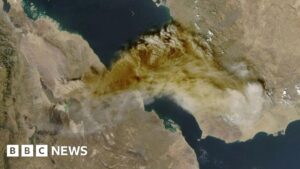
New Haven, Conn. — The enigmatic depths of the ocean have become a little less mysterious, thanks to a groundbreaking study that traces the evolution of marine sediment layers over hundreds of millions of years. This research illuminates the grand, yet intricate, process of world-building performed by marine animals through bioturbation — a term describing the excavation and mixing of sediments by burrowing organisms.
The study, led by Lidya Tarhan, an assistant professor of Earth and planetary sciences at Yale University, was published in the journal Science Advances. Tarhan describes bioturbation as one of the most crucial forms of ecosystem engineering, both in marine and terrestrial environments. “In the oceans, bioturbation plays a critical role in shaping the habitability and ecology of the seafloor, as well as in regulating nutrient cycling in overlying ocean waters,” Tarhan explained.
Historical Insights into Bioturbation
Bioturbation’s evolutionary timeline has long puzzled scientists. Tarhan’s team, through extensive research, has provided new insights into how these processes have changed over time. The team compiled a comprehensive database covering 540 million years of Earth’s history, using data from geologic fieldwork across the U.S., Canada, Spain, and Australia, as well as sediment drill cores from modern oceans.
The researchers discovered that the two primary types of bioturbation — burrowing and sediment mixing — evolved separately. Early in animal evolution, deep burrowing was prevalent, whereas sediment mixing took much longer to develop. “Burrowing animals such as worms, and later, clams and crustaceans were abundant and widespread, at least in the shallow oceans,” Tarhan noted. “It took longer for them to venture to the deep oceans. But sediment mixing lagged behind.”
Environmental Influences and Evolutionary Challenges
Ocean oxygen levels have played a significant role in the evolution of bioturbation. During periods of warmer, ‘greenhouse’ climates, low oxygen levels likely hindered the energy-intensive process of sediment mixing. “Ocean oxygen stress may have been a major driver,” Tarhan hypothesized, explaining that animals’ increased metabolic rates in warmer waters would have required more oxygen, prioritizing less-intensive burrowing over sediment mixing.
The study also sheds light on how bioturbation has responded to major environmental changes and extinction events. During the End-Permian mass extinction 252 million years ago, when over 90% of animal species were lost, bioturbation ceased temporarily. Small, horizontal burrows slowly began to reappear as ecosystems started to recover.
Implications for Modern Ecosystems
Understanding the historical patterns of bioturbation provides valuable insights into current ecological challenges. “Without a clear picture of how bioturbators responded to environmental stressors and how quickly they were able to rebound following extinctions, our understanding of the mechanics of the ecological cascades that drive extinction and dictate recovery is decidedly murky,” Tarhan stated.
The research team, which includes co-authors from institutions such as the University of Southampton, the University of Southern California, Riverside Community College, and the University of California, aims to further explore the role of reduced bioturbation in the reestablishment of ocean nutrients and the regrowth of ecosystems.
This study, funded by Yale and a National Science Foundation graduate research fellowship, highlights the importance of understanding past ecological processes to better predict the impacts of current environmental changes. As the world faces an ongoing extinction crisis, insights from ancient bioturbators could prove invaluable in shaping conservation strategies and ecological recovery efforts.







